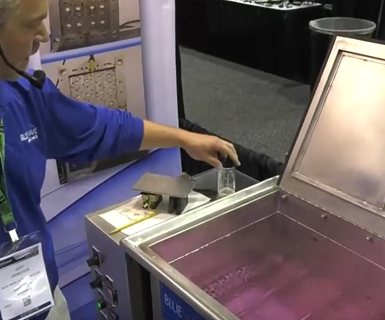Ultrasonic Cleaning Systems Produces High-Quality Outputs for Mold and Tool Shops
Blue Wave Ultrasonic Inc. manufactures heavy duty ultrasonic cleaning systems for the mold and tooling industry. Their heavy duty equipment can tolerate the heavy cycle times and high temperatures needed to produce high-quality outputs for mold and tool shops.
Blue Wave Ultrasonic Inc. manufactures heavy duty ultrasonic cleaning systems for the mold and tooling industry. Their heavy duty equipment can tolerate the heavy cycle times and high temperatures needed to produce high-quality outputs for mold and tool shops. Blue Wave's transducer, made of pure nickel, allows for supreme longevity in its life cycle, giving tool shops decades of quality production in their heavy duty cleaning systems. In this video from last year’s Amerimold, Jeff Hancock, sales director at Blue Wave demonstrates this technology.
Hancock: The benefit of our technology is that it does not break down over time and lasts for decades. This type is okay for cheap applications where you don't want to spend a lot of money, but you don't need something that's heavy duty. You'd find this on your jewelry cleaners, etc..
So, the purpose of either of these transducers is to create an ultrasonic pressure wave in the solution. To do that, we would have these transducers that are on the bottom of the tank or the side of the tank. We vibrate that transducer at an ultrasonic frequency. That creates pressure waves in the tank, and I can show you those pressure waves when I turn the system on.

I have glass balls in a glass jar. When I put these in here, you'll see the balls are just resting. When I turn the ultrasonics on, you'll see those balls just dance. The reason for that is the pressure waves are coming off of that diaphragm, going through the solution and pinging on that glass, causing the balls to bounce.
But it's not the pressure waves that actually clean the parts that we're putting in there. It's a habitation process that set up by the pressure waves, and the cavitation processes millions of microscopic imploding bubbles that in any instant time are collapsing and have a tremendous amount of energy. The only way to for me to show you that is to really clean something.
So, if I coat a ceramic disc with pencil lead, then put that in the tank and agitate it back and forth, you'll see that it's not magic. Nothing comes off of the ceramic. But when I turn the ultrasonic on, you see a blast off of there. That's those microscopic habitation bubbles that are cleaning and blasting off the contaminant from the substrate. Great thing about it is that there's no degradation to the metal. It's not strong enough to damage the tooling, so there's no abrasives. You're not rolling edges, you're not wearing away the tool and it saves a tremendous amount of time. The cavitation process is able to transmit through the metal and into water lines and into intricate details that normally any human could not get into and clean. That's what Blue Wave Ultrasonics is all about.
Related Content
-
Hands-on Workshop Teaches Mold Maintenance Process
Intensive workshop teaches the process of mold maintenance to help put an end to the firefighting culture of many toolrooms.
-
Precision Welding Services Offer Rapid Turnaround Mold Repair and Reduced Molder Downtime
X-Cell Tool & Mold relies on outsourced, high-quality welding repairs from Lewis-Bawol Welding to ensure its customers' molds are back in production quickly and affordably.
-
Portable Low-Heat, Non-Arcing Resistance Welder for Mold Repair
Rocklin’s user-friendly MoldMender Micro Welder delivers simple and cost-effective localized repair in-house with precision and versatility, enhancing mold and die durability and reducing disassembly and downtime.














